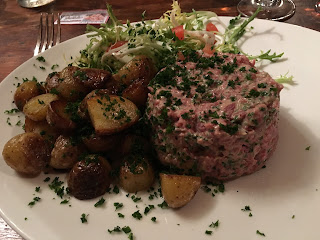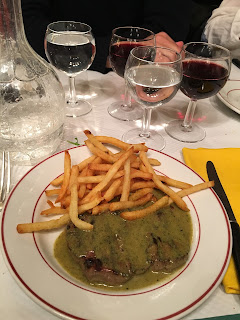Turkey is very interesting in its history and geography. Turkey has been part of many early empires of history including the Persian Empire and the Ottoman Empire. It is located in a place that serves to be the gateway to Asia and Europe. Turkey is literally the bridge of both worlds, the best of both worlds! The cuisine of Turkey thus has been immensely influenced throughout history and influenced others too. Turkey has so much delicious food that we might not know of like Kofta or foods we might know like Kebab. Whether we know it or not, Turkey has so much food for us to explore so without further adieu, Mei Wei Café brings you on another Rendezvous and this time we will discover:
Turkish Cuisine!
 |
| The ancient and beautiful city of Istanbul |
 |
| Meze, an appetizer serving before main meals. Yes these are all just appetizers... I'm moving to Turkey now |
 |
| The bridge between Asia and Europe has shaped the cuisine in many ways |
History and Geography:
The history of the Turkish cuisine is very significant as it carries on the tradition and cuisine of the Ottoman Empire. The Ottoman Empire was a very large and influential dynasty that ruled much of Eastern Europe and Central Asia for ages. For a long time, it was one of the richest nations in this world. This lavish nation bordered by many cultures of course experienced tremendous wealth in cuisine marking some of the most defined dishes like dolma, a grape leaf wrapped dish. Geographically speaking, Turkey's cuisine varies from region to region. For instance, West Turkey has more olive trees thus dishes use more olive oil. Geographically, Turkey is located in the best spot to have a very unique cuisine, borrowing cuisines from Europe and Asia. The Turkish cuisine is very similar and influences the cuisine of Greece, the Middle East, Central Asia, Jewish cuisine, the Balkans, and Europe. Wherever there are ethnic Turks, there will be a Turkish related cuisine. This includes Iran and even China! When it comes to food, Turkey is very open minded and uses many ideas and ingredients. The Silk Road reaching India and China also ran through Turkey thus the exchange of ideas and foods existed very early. So due to these factors, Turkey has some of the most appealing and unique cuisines.
 |
| Olives are an important essence of Mediterranean cuisine, including Turkey. |
 |
| The Ottoman Empire had luxurious feasts and dishes. Luckily, a lot of this tradition served into Turkish cuisine. |
Breakfast:
The Turkish cuisine could be expressed just through breakfast. Breakfast is perhaps the most important meal in Turkey and it is done massively. Breakfast or "before coffee" is amazing in Turkey! It includes so many things like nuts, cheese, yogurt, soups, meats, bread, and so much more! It is not uncommon for breakfast to resemble a feast in Turkey! This is especially true if you are having menemen, a Turkish specialty that is a huge festive platter for breakfast. This meal commonly includes scrambled eggs, tomatoes, green peppers, Beyaz Peynir (brined goat cheese), and many different breads like simit (Turkish bagel) and pogaca (Turkish focaccia). Another great pairing with Turkish breakfast is of course the famous Turkish tea and Turkish coffee, each usually brewed stronger than more western versions. The Turkish breakfast represents Turkish cuisine very well, beautiful, delicious, and extravagant.
 |
| Menemen, an extravagant breakfast that is fit for a Sultan! |
Meze:
Speaking of extravagant, the Turkish lavishness does not stop at breakfast. Before the main dish of a meal, the Turkish commonly have meze an appetizer portion that is also very festive and superb. Meze could be anything, like regional specialties including cheese, olive, dolma (filling wrapped in grape leaves), hummus, salads, meats, seafood, and so much more! Just looking at this "appetizer" platter is enough to satisfy anyone.
 |
| Meze is a great way to open the meal and show off the regional specialties. |
Ingredients:
As explained earlier, Turkey has a diverse pool of ingredients with ingredients tracing to China and the New World (the Americas). Turkey is very balanced when it comes to meats, vegetables, and fruits, as it is used in all dishes.
Meats and Seafood:
Meats and seafood are some of the most special part of Turkish cuisine, as everyone knows what a kebab or doner is. The main meat consumed in Turkey is lamb, and lamb from this region is REALLY good. Turkey also uses chicken, and beef. Turkey is a Muslim majority nation so pork is omitted. Being a nation with many contacts with the sea, Turkish cuisine also includes a lot of seafood, particularly sardines, anchovies, mussels, and squid (Kalamar). Did you know that tartar sauce for fried seafood is from Turkey? These meats of course are traditionally grilled like you see in doner vendors, but they can also be stewed, fried, and cooked in casseroles. To show how great the influence of Turkish meat is, kebab, lamb shanks, kofta (Turkish meatballs), and shish kebabs (skewered meats) are all Turkish dishes.
 |
| Turkish shish kebab |
 |
| Shwarma, doner, gyro, kebab, whatever you want to call it, this form of Turkish/Mediterranean BBQ is famous all over the world. |
 |
| Doner is a dish that is very common in Turkey and now at every street vendor in the world! |
Turkey has its fair share of grains and rice. With influence from Asia, Turkey enjoys rice dishes like pilaf as seen in many Middle Eastern cuisines, and many breads like in Europe. These breads and pastries come in many forms from bagels to flatbreads. The meat of Turkish food is often very heavy and the sauce is very creamy, thus the rice and bread is a great way to balance out the flavor.
 |
| Middle Eastern pilaf is very common throughout Turkey. |
Fruits and vegetables are another very important part of Turkish cuisine as it usually accompanies a lot of Turkish dishes. Yes, fruits are commonly served alongside meats. Some very essential vegetables in Turkey are green peppers, onions, garlic, lentils, tomatoes, and olives. A lot of essential fruits are dates, pomegranate, figs, apples, plums, grapes, pears, and apricots. It is not uncommon to see both fruits and vegetables served alongside dishes and meats or cooked into these dishes.
Dairy Products:
A lot of the dressing and sauces used in Turkish and other Mediterranean dishes are very creamy with a huge dairy presence. Yogurt is good here as it is said to have originated around this region. It is more lean and have a low fat content. Dairy is a huge part of the local diet and yogurt and other dairy products vary across different regions of Turkey. Cheese is usually goat and sheep cheese as sheep and goats are abundant and the preferred livestock. There are too many special cheeses to name but one of the most famous is Beyaz Peynir which is brined sheep cheese that is like feta cheese.
 |
| The famous Turkish Beyaz Peynir |
 |
| Yogurts and yogurt based sauces are very commonly used by locals in Turkey. |
Specialties:
There are a lot of special factors that define the Turkish cuisine that cannot be entirely named in this post, but here are some things that set it apart from similar and neighboring cuisines. As compared to Greeks (which Turkish cuisine is often compared to), Turkish cuisine uses more nuts like peanuts and pistachios. It also uses a lot of spices and seasonings when compared to similar cuisines. Olive oil, cumin, allspice, parsley, thyme, black pepper, and paprika are very common in many dishes. One very special dish from Turkey and the surrounding area are dolmas, a dish with filling that could be cooked vegetables or ground meat and other spices wrapped in grape leaves then cooked again. It is a very unique and iconic dish in Turkey. Another great part of the Turkish cuisine is how Westernized fast food is not as widespread in Turkey as is elsewhere. The Turkish people overall prefer home cooked meals than fast food. This is very important as the Ottoman and Turkish tradition can be preserved through the homemade cooking you would often encounter in Turkey.
 |
| Spices like these are very common in cities like Istanbul and makes the Turkish cuisine pack a powerful punch. |
 |
| Dolmas are grape wrapped treats unique to this region. |
Desserts:
Ok, so we discussed how important and extravagant breakfast and appetizer is to the Turkish cuisine, the final crucial part of this cuisine is the beautiful, fancy, and historical DESSERT! Turkish desserts is unlike any you will ever have, placing its roots as one of Europe's best and earliest producers of sweets. This again has to do with the geography and history of the Ottoman Empire with easy access to sugar and fruits. Also the Ottomans were unbelievably wealthy, and the Sultans loved to have huge feasts and desserts. Some very important desserts are lokums, better known as Turkish delights which has chopped dates, pistachios, walnuts, hazelnuts, and sugar all mixed in syrup or honey. This is a very tasty candy and one of the earliest and ongoing sweets from Europe. Baklava is a dessert made of layers of filo (thin pastries), nuts, and honey. This is one of my favorite Eastern European desserts as it is so sweet and chewy with bits of honey and nuts in every delightful bite. The list of Turkish desserts goes onwards, including Lokma (Fried dough covered in honey), Sutlac (Rice pudding with cinnamon), and Tavukgogsu (White chicken and milk pudding. I know sounds weird but its just like rice pudding). Desserts in Turkey could also be very famous with tourists, like Pondurma which is an ice cream cone sold in most large cities in Turkey. In Istanbul, it is common to see street vendors sell this ice cream while performing comedy and amusing antics to the buyer. Besides the fun, the ice cream is also unique in taste as it is stretchy and thicker than other ice creams. In conclusion Turkey has a deep history and tradition of sweets, pastries, and desserts with a lot of influence in Europe and the world. These desserts are traditionally lavish and to this day it is still very important to culture and extravagant in appearance. Even marzipan is said to be from Turkey!
 |
| Baklava is a dessert from the Mediterranean area with each nation having its own specialty. It is common to see pistachio used in Turkish baklava. |
 |
| Lokum or Turkish delights are definitely a must try for sweet lovers! It is very sweet and chewy full of flavor and fruits! |
Closing Thoughts:
Wow what a journey! Turkey is a historically and culturally rich nation that has influenced the world. One of the greatest things by the Turkish people is the wonderful cuisine. If you guys have not yet been familiar with Turkish food, I hope this teaches you something and inspires you to try some local Turkish food! From the flavorfully spiced meat to the beautifully and luxurious breakfast and desserts, Turkish cuisine is something we should all be familiar with. Lets all support Istanbul and Turkey by learning about the country, culture, and cuisine, and of course eating some of their amazing food! There are of course more to cover about Turkish food as I am sure to not have completely covered all there is to know about Turkish cuisine so contact me for questions, concerns, and suggestions on the next Rendezvous. Thanks for dining in Mei Wei Café and I will see you guys next time!
 |
| Güçlü Kal Turkey! |
Contact me at
Meiweicafe@gmail.com





















































